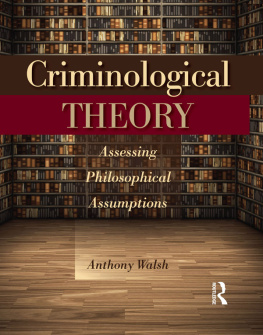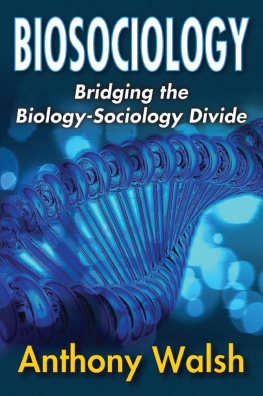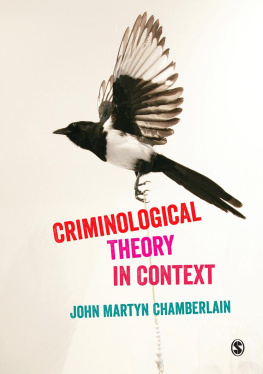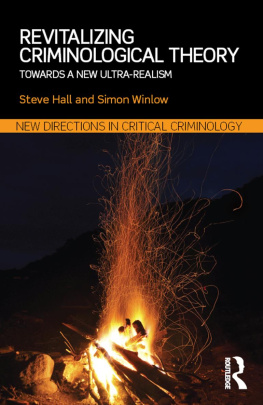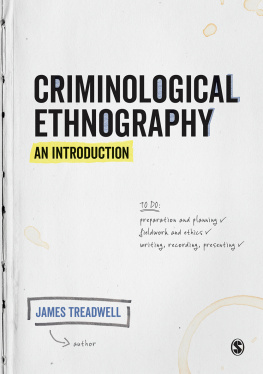First published 2014 by Anderson Publishing
Published 2015 by Routledge
2 Park Square, Milton Park, Abingdon, Oxon OX14 4RN
and by Routledge
711 Third Avenue, New York, NY 10017, USA
Routledge is an imprint of the Taylor & Francis Group, an informa business
Acquiring Editor: Pam Chester
Development Editor: Ellen S. Boyne
Project Manager: Julia Haynes
Designer: Tin Box Studio, Inc.
Copyright 2014 Taylor & Francis. All rights reserved.
No part of this book may be reprinted or reproduced or utilised in any form or by any electronic, mechanical, or other means, now known or hereafter invented, including photocopying and recording, or in any information storage or retrieval system, without permission in writing from the publishers.
Notices
No responsibility is assumed by the publisher for any injury and/or damage to persons or property as a matter of products liability, negligence or otherwise, or from any use of operation of any methods, products, instructions or ideas contained in the material herein.
Practitioners and researchers must always rely on their own experience and knowledge in evaluating and using any information, methods, compounds, or experiments described herein. In using such information or methods they should be mindful of their own safety and the safety of others, including parties for whom they have a professional responsibility.
Product or corporate names may be trademarks or registered trademarks, and are used only for identification and explanation without intent to infringe.
This book and the individual contributions contained in it are protected under copyright by the Publisher (other than as may be noted herein).
Library of Congress Cataloging-in-Publication Data
A catalogue record for this book is available from the Library of Congress.
British Library Cataloguing-in-Publication Data
A catalogue record for this book is available from the British Library.
ISBN 978-1-4557-7764-8 (pbk)
Typeset by TNQ Books and Journals
In his book, Why Do Criminals Offend? A General Theory of Crime and Delinquency (2005), noted criminologist Robert Agnew outlined a comprehensive theory drawing from sociology, psychology, genetics, neuroscience, and evolutionary biology. Although comprehensive, it is also parsimonious because it focuses on just two traits that are arguably the strongest individual-level traits associated with criminal behavior to be found in the literaturelow self-control and negative emotionality (which Agnew calls irritability). People take these traits with them into all life domainsfamily, school, peer groups, marriage, and workand these traits affect how others in those domains react to them in a process of what behavioral geneticists call evocative geneenvironment correlation.
Although it is an excellent book, Agnew writes in a later work that he came to realize that it is built on a weak foundation (2011:vii). Agnew has no quarrel with himself about what is in the book but, rather, with what he left out. What he did not pay attention to is what he calls foundational issues, which are the unspoken assumptions with which criminologists carry out their trade, and are what I call philosophical issues in this book. The issues Agnew explores in his new work ( Toward a Unified Criminology: Integrating Assumptions about Crime, People and Society, 2011) are determinism versus agency, the nature of human nature, the nature of society, and the nature of reality.
Agnew was much too hard on himself; how many books on criminological theory have you read that inquire about those things? Most such books simply assume that any philosophical assumptions underlying the various theories are either settled or are unproblematic. He was quite correct in his assertion that we must pay attention to foundational issues if the discipline is to progress beyond the deep divisions it now suffers and the constant recycling of old ideas into new theories that lead us nowhere.
The present book examines all of Agnews issues from a more philosophical angle and adds many others, such as justice, moral responsibility, rationality, emotions, punishment, ontology, epistemology, rationalism, empiricism, relativism, essentialism, realism, reductionism, and nominalism. Philosophers such as Aristotle, Plato, Kant, Hume, Descartes, and Schopenhauer long ago wrote about the same issues we struggle with today, and they provided answers that few modern writers, if any, have bettered. I thus introduce topics of interest to criminology and criminal justice with reference to philosophical traditions that emphasize the continuity of thought from the philosophical past to the scientific present.
This book should therefore be read as a philosophical look at criminology and not as a criminology theory text. It offers no systematic overview or analysis of criminological theories or perspectives; rather, it examines aspects of certain theories and perspectives for their philosophical assumptions, which may or may not be explicitly stated in them. Philosophy provides many nails to hang our conceptual hats on, clarifies many aspects of our thought, and helps immensely in developing critical thinking tools. Philosophy examines the grounds of our convictions and beliefs without providing definitive answers because that is not its task. Its task is rather to make us aware of them and to think more deeply and more precisely about them.
points out that many physicists, the grand masters of science, have found that philosophy provides a useful foundation for their thought, and that criminologists could benefit even more because, as Agnew notes, we rarely question our underlying assumptions. Philosophy has the ability to clarify our thoughts for us, to inform us of why we think about things the way we do, to solve some contradictions in our thinking we never knew existed, and even to dissolve some dichotomies we thought were cast in stone. One of those dichotomies is free willdeterminism. I make the case that criminology can live with both free will/agency, as posited by some theories, and determinism, as posited by others.
examines social constructionist and postmodernist thought in criminology. The agenda of those drawn to such approaches is not so much knowledge production as knowledge destruction/deconstruction. I address suggestions by others that perhaps they are drawn to anti-science positions by a genuine fear of knowledge they find distasteful. The main concern of this chapter is whether crime and criminality are social construction or palpably real, and it suggests from a critical realists position that the answer is both.
Relativism, rationalism, and empiricism are addressed in . Relativism denies there is truth or avers that there are many truths, all veridical in their own domains. Rationalism and empiricism are different epistemologies telling us that truth is attainablethe first using top-down analytic methods and the latter using bottom-up synthetic methods. Thomas Kuhns work on the nature of science and paradigms, with emphasis on his concept of the theory ladenness of data, is the primary focus of this chapter.
Essentialism and reductionism are the topics of . I argue that searching for generalities, patterns, similarities, and differences is the goal of science, and that anti-essentialists fail to make the distinction between Aristotles per se and per accidens essentialism. Reductionism is searching for causal explanations at fundamental levels. I show that chemistry, biology, and psychology went through an anti-reductionist phase in their youth, fearing for the autonomy of their disciplines, but finally accepted that the more fundamental science had much to offer and so fully integrated with it. When they did, their knowledge base increased enormously.

